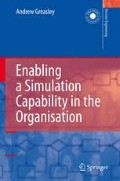Abstract
The use of simulation is both a technical issue involving model development and analysis and a process of the implementation of organisational change. This chapter discusses technical issues such as the selection of simulation software and organisational issues such as the selection of personnel and the acquisition of resources required to provide the capability to undertake a simulation project. It is important that the full costs of introducing simulation are considered, including user time and any necessary training activities. The potential benefits of simulation must also be estimated. One of the reasons simulation is not used more widely is the benefits from change, undertaken as a result of a simulation study can be difficult to quantify.
Access this chapter
Tax calculation will be finalised at checkout
Purchases are for personal use only
Preview
Unable to display preview. Download preview PDF.
References
Banks, J. and Gibson, R. (1997), Simulation Modelling: Some Programming Required, IIE Solutions, February, 26–31.
Cochran, J.K., Mackulak, G.T. and Savory, P.A. (1995), Simulation Project Characteristics in Industrial Settings, INTERFACES, 25: 4, 104–113.
Davies, R. and O’Keefe, R. (1989), Simulation Modelling with Pascal, Prentice-Hall Inc., New Jersey.
Greasley, A. (1996), The Use of Simulation Modelling in an Organisational Context, Proceedings of the IASTED/ISMM International Conference on Modelling and Simulation, April 25–27, IASTED.
Greasley, A. (1998), An Example of a Discrete-Event Simulation on a Spreadsheet, SIMULATION, 70: 3, 148–166.
Pidd, M. and Cassel, R.A. (2000), Taking Cues from Java: Featuring How Discrete Simulation and Java Can Light Up the Web, IEEE Potentials, February/March.
Rohrer, M. and Banks, J. (1998), Required Skills of a Simulation Analyst, IIE Solutions, May, 20–23.
Sprague, R.H. and Watson, H.J. (eds), (1993), Decision Support Systems: Putting Theory into Practice, Third Edition, Prentice-Hall Inc., New Jersey.
Rights and permissions
Copyright information
© 2008 Springer London
About this chapter
Cite this chapter
(2008). Acquiring the Resources for Simulation. In: Enabling a Simulation Capability in the Organisation. Decision Engineering. Springer, London. https://doi.org/10.1007/978-1-84800-169-5_3
Download citation
DOI: https://doi.org/10.1007/978-1-84800-169-5_3
Publisher Name: Springer, London
Print ISBN: 978-1-84800-168-8
Online ISBN: 978-1-84800-169-5
eBook Packages: EngineeringEngineering (R0)

